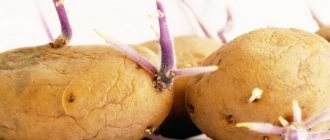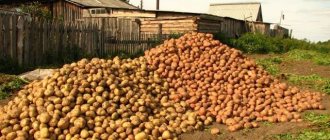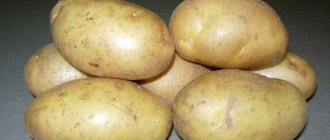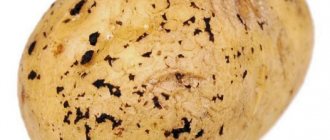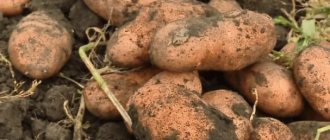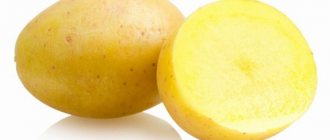Description of the potato variety Giant
The Giant potato was developed in Russia. Breeders from the All-Russian Research Institute of Potato Farming named after Lorch and Agro LLC participated in its creation. Included in the State Register in 2013. The variety is recommended for cultivation in the middle zone, the Volga-Vyatka region and the Black Earth Region.
Main characteristics:
- mid-season – 80–100 days;
- table – mass fraction of starch 16–19%;
- tall – 70–80 cm;
- plant of intermediate type.
The Giant potato bush is spreading, semi-erect, with large leaves of an intermediate type, painted in a rich dark green color. The corollas are small, medium in size, red-violet in color.
Each bush produces from 8 to 13 tubers with a diameter of 4–5 cm and weighing 100–140 g.
The pulp is cream-colored, dense, and does not overcook. According to the State Register, the taste of the Giant potato is “good and excellent.” It can be used to prepare any dishes.
Attention! The yield of commercial fruits of the Giant potato reaches 87–98%.
Combined with high yield (up to 420 kg per hundred square meters), this makes the variety profitable, so it is grown not only by summer residents, but also by farmers.
The shape of the Giant potato tubers is oval-round, the surface is light beige, smooth, with inconspicuous eyes of medium depth
General description of the variety
The giant is a product of domestic selection. His resident is the A. G. Lorch Research Institute. The variety is relatively young. It was included in the Russian State Register in 2013. Since then, the Giant has managed to win the love of many gardeners.
Distinctive features of the Giant
The main distinguishing feature of the Giant potato is the aligned large tubers. They make up the vast majority of the harvest; non-commercial small items are extremely rare.
Important! The size of potatoes of this variety depends on the composition of the soil. The more nutritious the soil, the larger the tubers will be.
Giant contains an increased amount of starch. Thanks to this property, the variety acquires a golden-brown, crispy crust when fried and baked.
Potatoes contain many beneficial substances.
Among them:
- vitamins B, A, C, PP, K, E, betaine, beta-carotene, lutein;
- micro- and macroelements - potassium, calcium, zinc, selenium, manganese, phosphorus, sodium, magnesium, iron;
- fatty acids, including Omega-3 and Omega-6;
- nonessential and essential amino acids.
Main characteristics of the Giant potato
Potato Giant is a variety that definitely won’t let you down. It produces a rich harvest even in dry summers and is unpretentious.
Characteristics of the Giant potato:
| Parameter | Index |
| Ground part of the plant | The bushes are tall, semi-erect. Medium spreading. Abundantly form green mass. The leaves are large, with a wavy edge. The color is dark green, dull, matte. The veins are clearly defined. The inflorescences are compact and consist of small red-violet flowers. Few berries are produced. The plant fades quickly. The root system is powerful. 10-15 large tubers are formed under each bush. |
| Tubers | Large, aligned, oval-rounded. The weight of each tuber varies between 100-150 g. The skin is thin but durable, glossy, smooth, and light beige in color. The pulp is creamy, yellowish. The taste is sweetish, the aroma is rich. Doesn't darken when cutting. During heat treatment it becomes moderately crumbly, but does not boil over. There are many eyes, they are deep but inward and pigmented with pink color. The starch concentration in tubers is high - 17-19%. |
| Ripening time | Mid-season. It takes 70-90 days from sowing tubers to harvesting. |
| Productivity | High. From 1 m² of plantings up to 5 kg of crop is harvested. One bush produces up to 15 tubers. They are all large. Marketability reaches 97%. |
| Transportability | High. Tubers are suitable for transportation over long distances. They are stored throughout the winter without changing their taste. |
| Immunity to disease | It has high immunity to potato cancer, leaf curl, striped and wrinkled mosaic, rhizoctonia, and scab. Resistance to late blight and golden nematode is low. |
| Features of cultivation | Recommended for cultivation in the Central, Central Black Earth and Volga-Vyatka regions. |
Characteristics of the Giant potato variety
The variety is unpretentious and tolerates drought and short-term frosts. The shelf life indicator is high – 97%. It has good transportability. It is used for cooking (it produces an airy, tender puree), stewing, and frying. On an industrial scale, tubers are used to produce starch and dry puree. The pulp does not darken during heat treatment.
Productivity
Giant potatoes ripen 3–3.5 months after emergence. Tubers can be dug up in mid-August. The yield indicator is:
- 1–1.8 kg per bush;
- 2.9–4.2 kg per 1 m2;
- 290–420 kg per 1 hundred square meters.
The maximum figure is 613 kg per hundred square meters. This result can only be achieved if you grow Giant potatoes on fertile soils with a light structure, and also if you follow standard rules of agricultural technology:
- watering is rare but plentiful;
- loosening and weeding - regularly;
- feeding - three times per season;
- hilling - 2-3 times.
Advantages and disadvantages
Giant potatoes are valued by many summer residents for their high yield and excellent taste. Tubers can be stored for a long time. They are characterized by a high starch content and are suitable for making purees.
The main advantage of the Giant potato is its pleasant taste.
pros
- good yield;
- excellent taste;
- attractive presentation;
- high shelf life and transportability;
- immunity to many diseases;
- drought resistance;
- low maintenance requirements.
Minuses
- grows poorly on clay soils;
- average resistance to late blight.
Diseases and pests
Potato variety "Giant":
- Is immune against potato cancer, leaf curl virus, wrinkled or striped mosaic, common scab, rhizoctonia;
- Susceptible to golden cyst nematode;
- Has average resistance to late blight.
Giant seed potatoes. Brief overview, description of characteristics:
Necessary preventive measures:
- During a late blight epidemic, potato plantings are sprayed with copper-containing preparations;
- Before planting, remove plant residues from the soil;
- Treat infected plantings using industrial insecticides or non-toxic biological products;
- Carrying out pre-planting treatment of seed material will protect potatoes from wireworms.
Landing rules
Giant potatoes are planted in early May, when the soil warms up to 8–10 °C, which can be easily checked with a thermometer. It is buried in the hole and kept for 10–15 minutes. The soil is prepared in autumn or spring. The area is cleared and dug up. If the soil is depleted, humus up to 5–7 kg per 1 m2 or complex fertilizer 40–50 g per 1 m2 is added to it. If the soil is clayey or heavy, you need to add sawdust or sand in an amount of 500–800 g to the same area.
Giant potato tubers are also prepared in advance. They are laid out in a lighted room a month before planting, periodically moistened, and on the last day treated with Bordeaux mixture or other fungicide to protect against fungal diseases. Only sprouted tubers need to be planted. If the sprouts still do not appear, the root crops can be placed in the open sun for several days - this will increase germination.
Giant potatoes are planted in three ways:
- If the soil is light (sandy, sandy loam), then it can be planted in a trench with maximum depth.
- On loams - in ridges, average depth.
- If the soil is clayey, it is suitable for a shovel, the depth is minimal.
Landing algorithm:
- Form furrows at a distance of 70 cm.
- Place the tubers to a depth of 5 to 10 cm (depending on soil type).
- Sprinkle with wood ash and soil.
- Water at the rate of one bucket per 3-4 bushes.
Advantages of the variety
The Giant variety has a positive characteristic. Gardeners highlight the following features:
- delicious fruits;
- marketability is 89-96%;
- good keeping quality;
- contains a lot of starch;
- the giant is resistant to many diseases;
- grows well in severe drought and cold;
- the ability to transport potatoes without damage.
Flaws
The disadvantages include the fact that the plant is easily susceptible to potato nematode. The variety is also demanding on soil composition. It grows poorly on loamy soils and does not tolerate strong moisture.
Related article: Potato variety “Red Fantasy” - description and photo
Features of cultivation
The agricultural technology of the Giant potato is not fundamentally different from the technology for growing other varieties:
- Watering and fertilizing after emergence, then before and after flowering. For the first time, you can give nitrogen (urea, slurry), then a complex mineral fertilizer (for example, azophosphate).
- Loosening - after watering and rains.
- Weeding - as necessary.
- Hilling - 2-3 times per season: after the tops grow to 20 cm, then every 2 weeks.
In the southern regions, the height of the ridge is set at 15–20 cm to protect the tubers from the scorching sun
Rules of care
The Giant potato loves attention during the ripening period, because this will help the roots to form well and the tubers to develop throughout the entire growth period. The basic requirements are presented below.
- When growing potatoes, it is very important to carry out proper hilling. Hilling removes all weeds; after it, loosening near the bushes does not need to be done. This procedure protects the fruits from increasing temperatures and provides a comfortable environment for fruit ripening.
- It is important to water the area correctly and at the right time. It is watering that affects the quality and growth of tubers. If there is not enough moisture, the roots of the plant may begin to die. This fact can greatly affect the amount of harvest.
- The variety needs fertilizing and fertilizers, their amount depends on the soil itself and the zone of climacteric conditions. Potatoes respond positively to manure in any land. To significantly increase productivity, you need to apply manure to soddy-podzolic lands, as well as sandy and sandy loam. In these soils you can grow potatoes and harvest a large amount of crops.
- Tubers are also sprayed to prevent diseases. For this purpose, modern drugs are used, such as Kinmiks, Arriv, Tsimbush, Kuproxat, Sandofan M8 and Ditan M-45.
Pests and diseases
Potato Giant has good resistance to cancer and golden nematode. Immunity to other diseases is average:
- late blight on tubers and tops;
- wrinkled mosaic;
- striped mosaic;
- leaf curling.
Therefore, summer residents and farmers should not neglect standard preventive measures. It is necessary to observe crop rotation and treat the tubers before planting with a fungicide, for example, Fitosporin or Khomom. Potatoes should not be planted for more than three years in the same area. Tomatoes will be bad predecessors for the crop.
After seedlings emerge, they can be additionally treated with fungicides. In summer it is recommended to spray insecticides against insects:
- "Decis";
- "Biotlin";
- "Spark";
- "Aktara";
- "Fufanon."
In order not to abuse chemicals, you can use traditional methods:
- pour sawdust between rows;
- water the soil with a weak tar solution;
- lure Colorado potato beetles into traps;
- dust the bushes with ash;
- Sprinkle with infusion of garlic, mustard powder, chili pepper.
Advice! Next to the Giant potatoes you can grow marigolds, coriander, calendula, and fragrant tobacco.
Characteristics of the variety
Potato Giant is a mid-season table variety. It was bred by Russian breeders in 2013. It is best grown in Russia, in the central part, the Volga-Vyatka and central black earth parts.
Potato ripening time is from 115 to 120 days. Productivity pleases with its high level and quality; it ranges from 290-424 c/ha. The potato root system is very developed; 8-13 fruits are formed under one bush.
Description of the plant
Description of the plant - a tall bush with straight stems, moderately lush branches. During the ripening period, the plant produces small corollas of purple color.
The leaves are quite large, green in color with wavy edges. The root structure is well developed.
Description of fruits
The weight of one fruit is approximately 110-180 g. Description of the potato: white flesh, creamy skin. The fruits are round in shape, slightly elongated. There are eyes, they are medium-sized, recessed. Potatoes contain a lot of starch, around 18.9%, so they soften well during boiling. Keeping quality is 97%, so it can be stored for a long time.
The Giant potato variety has an exquisite taste. Potatoes can be boiled, fried, baked and stewed. When cooked, puree turns out to be especially tasty due to its ability to boil well. The flesh does not turn black during cooking. You can make starch and potato flour from potatoes.
Harvesting and storage
The collection takes place in mid-August. To do this, choose a warm day without rain or strong wind. It is recommended to mow the tops 1–2 weeks before this so that the tubers have time to ripen. Digging is carried out manually or using a walk-behind tractor. The tubers are dried and put into bags for storage. In the first two weeks they are kept in cool conditions (up to +15–16 °C), and then sent to a dark room. Store all winter at a temperature of +3–5 °C and humidity 70–80%.
Important! Potatoes are sorted: small and damaged tubers are used for food first. Medium and large root crops are sent for storage.
Harvesting is carried out in dry weather
Advantages and disadvantages
Many vegetable growers are attracted to the Giant potato by its smooth, large tubers of excellent commercial quality and taste. When cleaned, they do not change color, do not darken, and after cooking they do not become overcooked, but acquire a delicate taste and aroma. You can use Giant potatoes to prepare all sorts of dishes that include potatoes: they look great in any of them, decorate them and make the taste more harmonious. Due to the high concentration of starch, these potatoes are used to make starch and to make dry mashed potatoes.
How to plant and grow pineapple at home from the top or using seeds
In addition to this undoubted advantage, the Giant variety of potatoes demonstrates:
- resistance of seed tubers to degeneration;
- good tolerance to drought and high temperatures;
- marketability of harvested tubers is 87-98%;
- high yield (from 1 sq. m of beds allocated for this potato, you can collect 2.9-4.2 kg of tubers, which is 0.6-1 kg higher than the yield of varieties such as Petersburg and Chaika, recognized as the standard).
- excellent keeping quality of the crop (97% of tubers can last until the end of storage).
No significant deficiencies were identified in potatoes of this domestic variety. Its features include intolerance to stagnation of moisture in the ground and some demands on the type of soil: it grows poorly on heavy loams.


